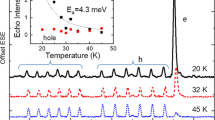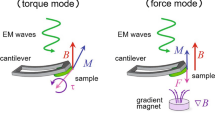Abstract
A new version of the optically detected electron spin resonance (OD ESR) technique using vacuum ultraviolet radiation to generate radical ion pairs is discussed. The technique can be used to study the spin-correlated processes of charge recombination in thin films that can be useful in spintronics. Distinctive features of photoionization and high-energy (including X-ray) ionization are discussed. The first results obtained by the technique in the study of charge recombination in polymeric and liquid crystal films are presented. The results of the concurrent observation of the OD ESR and electron cyclotron resonance (ECR) in the low-pressure gas over the sample are outlined. A possible application of ECR in the context of the OD ESR spectroscopy is suggested.




Similar content being viewed by others
Notes
Note that upon absorption in such thin layers one should take into account a possible damage to surface of the objects under study by VUV quanta. For a brief discussion of this issue see Sect. 4.
References
E.L. Frankevich, A.I. Pristupa, V.I. Lesin, Chem. Phys. Lett. 47, 304 (1977)
E.L. Frankevich, A.I. Pristupa, V.I. Lesin, Chem. Phys. Lett. 54, 99 (1978)
O.A. Anisimov, V.M. Grigoryants, V.K. Molchanov, Yu.N. Molin, Chem. Phys. Lett. 66, 265 (1979)
O.A. Anisimov, in Radical Ionic Systems, ed. by A. Lund, M. Shiotani (Kluwer Academic Publishers, Dordrecht, 1991) pp. 285–309
A.D. Trifunac, J.P. Smith, Chem. Phys. Lett. 73, 94 (1980)
I.A. Shkrob, A.D. Trifunac, Radiat. Phys. Chem. 50, 227 (1997)
A.V. Koptyug, E. Sorman, Meas. Sci. Technol. 5, 797 (1994)
V.N. Verkhovlyuk, E.V. Kalneus, O.A. Anisimov, Pribory i Tekhnika Eksperimenta (2014) (in press)
C.J. Lawrence, Phys. Fluids 31, 2786 (1988)
I.C. Lewis, L.S. Singer, J. Chem. Phys. 43, 2712 (1965)
K.H. Hausser, L. Mongini, R. van Steenwinkel, Z. Naturforsch. A Phys. Phys. Chem., Kosmophys. 19, 777 (1964)
M. Okazaki, Y. Tai, K. Toriyama, Bull. Chem. Soc. Jpn. 66, 748 (1993)
G.S. Park, Trans. Faraday Soc. 47, 1007 (1951)
E.H. Martin, J. Hirsch, J. Non Cryst. Solids 4, 133 (1970)
S. Murakami, H. Naito, M. Okuda, A. Sugimura, J. Appl. Phys. 78, 4533 (1995)
V.O. Saik, N.N. Lukzen, V.M. Grigoryants, O.A. Anisimov, A.B. Doktorov, Yu.N. Molin, Chem. Phys. 84, 421 (1984)
B.A. Belyaev, N.A. Drokin, V.F. Shabanov, V.N. Shepov, Phys. Solid State 42, 577 (2000)
J.G. Dorfman, Doklady Akad. Nauk. U.S.S.R. 81, 765 (1951)
R.B. Dingle, Proc. R. Soc. (London) A212, 38 (1952)
P. Grubling, J. Hollandt, G. Ulm, Rev. Sci. Instr. 71, 1200 (2000)
P.G. Baranov, Yu.P. Veshchunov, R.A. Zhitnikov, N.G. Romanov, Yu.G. Shreter, JETP Lett. 26, 249 (1977)
M. Godlewski, W.M. Chen, B. Monemar, Crit. Rev. Solid State Mater. Sci. 19, 241 (1994)
M.B. Comisarow, A.G. Marshall, Chem. Phys. Lett. 25, 282 (1974)
Acknowledgments
The work was supported by the Program “Leading Scientific Schools” (project No. NSh 5744.2014.3).
Author information
Authors and Affiliations
Corresponding author
Rights and permissions
About this article
Cite this article
Anisimov, O.A., Verkhovlyuk, V.N., Zikirin, S.B. et al. New Possibilities of OD ESR: Vacuum Ultraviolet Generation of Radical Ion Pairs. Appl Magn Reson 45, 881–892 (2014). https://doi.org/10.1007/s00723-014-0560-4
Received:
Revised:
Published:
Issue Date:
DOI: https://doi.org/10.1007/s00723-014-0560-4




